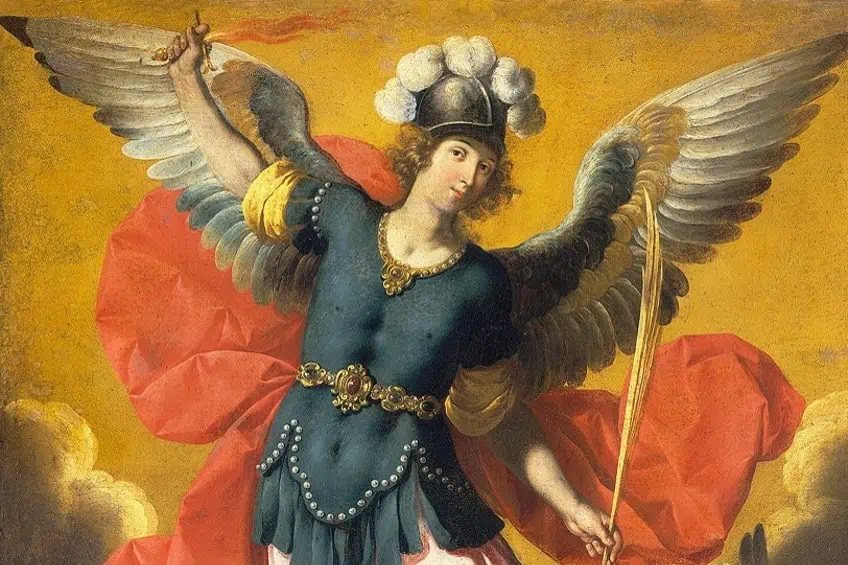Angel Art History – Famous Angels in Renaissance Paintings
Angels are sacred symbols in many belief systems across the world that bring a sense of comfort and connection to the spiritual world. Angels have also served as representations of “universal messengers”, who have inspired artists for centuries and feature in some of the most famous works of art by renowned artists. In this article, we will provide you with a breakdown of the origin of angels in art history, including the top 13 most famous angel paintings of all time. Read on for more about the role of angels in art!
Contents
- 1 The Origins of Angels in Art
- 2 Top 13 Most Famous Angel Paintings of All Time
- 2.1 The Annunciation (c. 2nd – 3rd CE) by Unknown
- 2.2 Annunciation to the Shepherds (1002 – 1012) by the Liuthar Circle of Illuminators
- 2.3 The Temptation of Christ by the Devil (c. 1129 – 1134) by Catalonian Painters
- 2.4 Guardian Angel Nimbed (c. 1415 – 1420) by the Master of the Morgon Infancy Cycle
- 2.5 Mi‘rajnama: The Book of the Prophet Muhammads’ Ascension (c. 1436) by Unknown
- 2.6 The Creation of the World and the Expulsion from Paradise (c. 1445) by Giovanni di Paolo
- 2.7 Annunciation (1472) by Leonardo da Vinci
- 2.8 The Translation of the Holy House of Loreto (c. 1490) by Saturnino Gatti
- 2.9 The Sistine Madonna (1512 – 1513) by Raphael
- 2.10 Saint Michael the Archangel (c. 1640s) by Ignacio de Ries
- 2.11 The Dead Christ with Angels (1864) by Édouard Manet
- 2.12 Song of the Angels (1881) by William-Adolphe Bouguereau
- 2.13 Flying Celestial (Apsara) with Musical Instrument (1942 – 1943) by Xie Zhiliu
- 3 Frequently Asked Questions
The Origins of Angels in Art
When studying angel art history, it is important to understand the context of the idea of an angel and what it represents across different cultures and religious belief systems. Angels are often perceived as divine creatures of beauty, purity, innocence, justice, and icons of faith who have occupied art history since the 3rd century. Humans have referenced the term “angel” across the arts as heavenly creatures that form part of many religious belief systems, including, but not limited to, Judaism, Christianity, and Islam.
The term “angel” was translated from a Hebrew word meaning “messenger”, which refers to heavenly creatures that form the lowest of nine orders in the Christian celestial hierarchy.
In the 19th century, Noah Webster first defined the term based on “messenger” followed by connotations of a spirit who serves as an ambassador of God or is employed by God to perform certain tasks. In Islam and Christianity, there are specific angels dedicated to performing different tasks, each with different names as per the belief system. The Judaic tradition also breaks down the different types of celestial spirits into angels, archangels, cherubim, and seraphim, similar to traditional Christian celestial ranking. In each religion, the ranking and order of angels and their superiors differ, yet it is clear that the role of angels, cherubims, seraphim, and archangels all played a significant role in the cultural development of many groups of people around the world.

Angels have been immortalized in art across the mediums of painting, drawing, and sculpture since the discovery of early Christian art. The representation of angels did not always include majestic wings as seen in some of the famous examples of angel paintings below, but early representations were based on the image of young men after the biblical reference to Gabriel in the book of Daniel stated that Gabriel appeared in the “likeness of man” and not necessarily man himself. An early artwork portraying the biblical scene of the Annunciation illustrated Gabriel without wings as well as relief carvings on early Christian sarcophagi.
Since then, angels in art have remained a genre of their own, increasing in popularity across the Byzantium, Medieval, and Renaissance periods. Angels also appeared in manuscripts found in ancient Islamic literature featuring representations of angels as bright-winged beings.
Angels in art also appear in Ottoman and Timurid manuscripts. Most of the famous art movements following the Byzantine period incorporate angelic creatures into art and sometimes use real models to base angelic representations on. Neoclassicism and the early Renaissance periods in European art have been incredibly influential since most angel paintings were executed for religious purposes. Below, we will look at a few angels in Renaissance paintings that will have you fascinated by the history of angels in painting.
Top 13 Most Famous Angel Paintings of All Time
In angel art history, the image of angels, or their physical form, has been debated since these are imagined figures whose representation has solely been inspired by religious literature. Artists have adopted creative approaches to imagining how these angelic icons might appear and have immortalized their imagined faces in art history. Below, we will dive into the top 13 most famous angel paintings in angel art history!
The Annunciation (c. 2nd – 3rd CE) by Unknown
| Artist Name | Unknown |
| Date | c. late 2nd – 3rd century |
| Medium | Fresco |
| Dimensions (cm) | Unavailable |
| Where It Is Housed | Catacombs of Priscilla, Rome, Italy |
The Annunciation of the catacombs is one of the most famous old paintings of angels that is incredibly profound. The artwork is an early Christian painting by an unknown Italian artist who once decorated the walls of the Priscilla catacombs in Rome. The image dates to between the late 2nd and 3rd centuries CE and was executed in a traditional fresco style. The catacombs of Priscilla contain some of the most treasured early Christian artworks, which echoes the importance of the catacombs themselves.
The catacomb of Priscilla is a rich archaeological site located in an ancient Roman quarry site in Via Salaria. In this catacomb, many martyrs and popes were buried and contained over 40,000 burials.
The Priscilla catacombs were constructed out of a porous volcanic stone called tufa between the 2nd and the 5th centuries. The name of the site was attributed to the wife of Manius Acilius Glabrio who was murdered under the order of Roman emperor Domitian after he became a Christian.
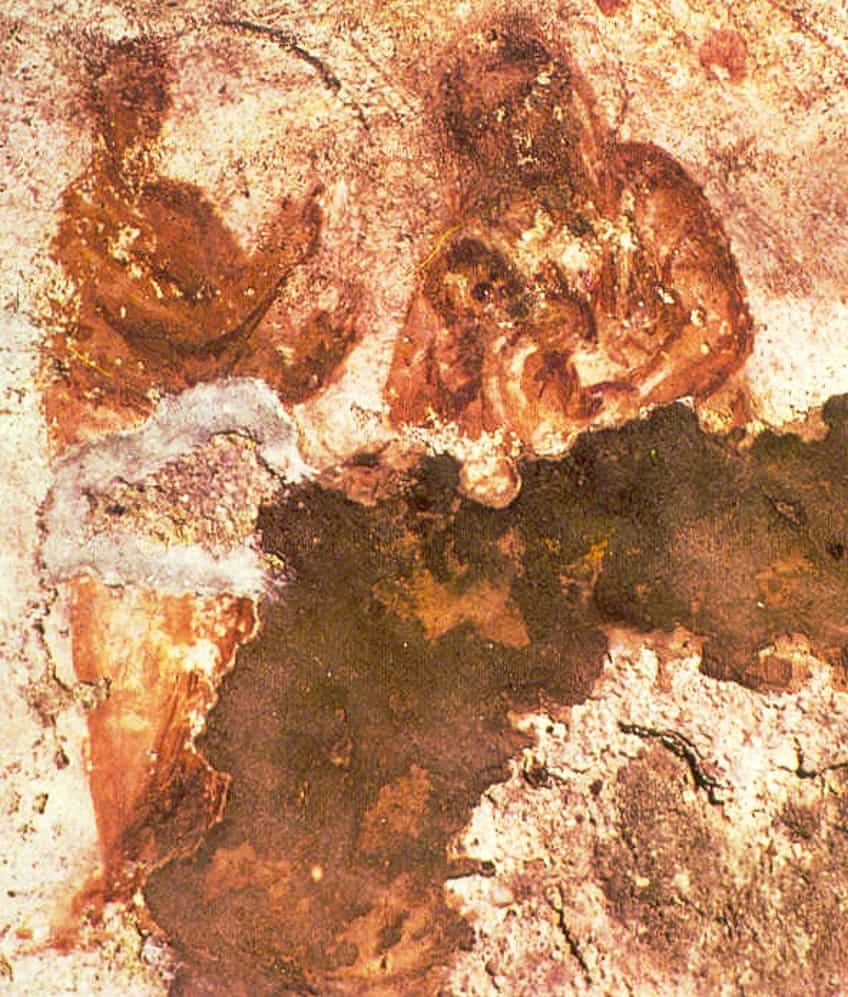
The catacomb is home to many interesting frescoes and biblical paintings, including images of saints with early religious symbols and scenes of the Good Shepherd, figures of the Madonna and Child, as well as this early angel painting, believed to be The Annunciation. While the scene is still contested, the catacomb does house some of the oldest known Marian paintings so it would be odd if the artists excluded the Annunciation scene from the many other scenes from the life of the Madonna. In this scene, the archangel Gabriel announced to Mary that she would bear a child via virgin birth, who would be the son of God. This is perhaps one of the oldest paintings of an angel without wings.
Other representations of angels without wings were common in earlier periods and can be seen on many other relics and sculptural objects, including the Sarcophagus of Junius Bassus (c. 359 CE) in the scene depicting Abraham about to sacrifice Isaac.
Annunciation to the Shepherds (1002 – 1012) by the Liuthar Circle of Illuminators
| Artist Name | The Liuthar Circle of Illuminators |
| Date | 1002 – 1012 |
| Medium | Illuminated manuscript illustration; ink on paper |
| Dimensions (cm) | 42.5 x 32 |
| Where It Is Housed | The Bavarian State Library, Munich, Germany |
This famous angel painting features an illuminated manuscript produced by the Liuthar circle of illuminators for the last Holy Roman emperor, King Henry II. The group of artists who collaborated on the text and artwork worked at a monastery in Rechenau and demonstrated the developing style of Ottonian angel art.
The stylization of the angel painting strays from classical representations of flattened figures and emphasis on gesture.
The painting, Annunciation to the Shepherds portrays a large angel hovering over the shepherd and his sheep and is reminiscent of the introduction of the gold background in later illuminated artwork. Ottonian manuscripts were created for liturgical purposes and were also examples of the empire’s desire to develop a visual connection to the Christian leaders of late antiquity and reflect the artistic influences from late Roman, Carolingian, and Byzantine art traditions.
The Temptation of Christ by the Devil (c. 1129 – 1134) by Catalonian Painters
| Artist Name | Catalonian Painters |
| Date | c. 1129 – 1134 |
| Medium | Fresco transferred on canvas |
| Dimensions (cm) | 176.5 × 299.7 |
| Where It Is Housed | The Metropolitan Museum of Art, New York City, United States |
One cannot discuss old paintings of angels without including one of God’s fallen angels, the devil, who is seen in an early 12th-century painting The Temptation of Christ by the Devil. The fresco was created by a group of Catalonian artists who operated in a workshop based in Castile-León, Spain, who were commissioned to decorate the church of San Baudelio de Berlanga.
Some of the frescoes portray traditional scenes from Christ’s life on Earth with this scene illustrating the account from the gospel of Matthew where Christ was tempted by the devil in the desert after fasting for 40 days.

The devil, who also appears with wings, appears before Jesus many times, offering him power and also encouraging him to commit suicide. The third temptation sees Christ being ministered to by the angels, which appear like a comic strip while illustrating the passage of time.
Guardian Angel Nimbed (c. 1415 – 1420) by the Master of the Morgon Infancy Cycle
| Artist Name | Master of the Morgon Infancy Cycle |
| Date | c. 1415 – 1420 |
| Medium | Illuminated manuscript illustration |
| Dimensions (cm) | 15.8 x 10.8 |
| Where It Is Housed | The Morgan Library and Museum, New York City, United States |
Guardian Angel Nimbed is an illustration from a Book of Hours, which is an illuminated manuscript from either the Netherlands or Delft. The angel illustration depicts an angel in a celestial royal blue cloak with wings that contain mint green inner feathers and blue outer feathers.
The angel is unnamed but is painted with a diadem (crown) while reading a book.
The barefoot angel is a classic example of the Medieval approach to angel art followed by the introduction of the golden illuminated background, which can be seen throughout the Byzantine era. The Book of Hours from which the angel painting is derived reflects the early Catholic art styles of the 15th century and was created by an illuminator of the Morgon infancy cycle.
Mi‘rajnama: The Book of the Prophet Muhammads’ Ascension (c. 1436) by Unknown
| Artist Name | Unknown |
| Date | c. 1436 |
| Medium | Illuminated manuscript |
| Dimensions (cm) | 34,5 x 24,5 |
| Where It Is Housed | Bibliothèque Nationale de France, Paris, France |
This illustrated manuscript was created for the Timurid leader Shahrukh who reigned during the first quarter of the 15th century and contains many beautiful and vivid paintings of the ascension cycle in Islamic art. The cycle is also known as the Mi’raj paintings and portrays the syncretistic art style of Islamic painting as seen in Central Asian and Iranian art of the Timurid period.
This period also saw many interactions between the eastern world and the Islamic regions, which produced intriguing artworks and angel paintings.
This manuscript contains Islamic iconography with influences from Chinese Buddhism and Asian texts. The Mi‘rajnama text contains text that was originally used in Buddhist literature, which is a significant marker of the emergence of non-Arabic text in Islamic lands during the century. The many stunning paintings illustrate the angels as colorful-winged creatures with human bodies and even multiple faces.
The Creation of the World and the Expulsion from Paradise (c. 1445) by Giovanni di Paolo
| Artist Name | Giovanni di Paolo di Grazia (1398 – 1482) |
| Date | c. 1445 |
| Medium | Tempera and gold on wood |
| Dimensions (cm) | 46.4 x 52.1 |
| Where It Is Housed | The Metropolitan Museum of Art, New York City, United States |
This Renaissance angel painting was created by Italian artist Giovanni di Paolo who was a popular Sienese painter and illustrator who also worked on Dante Alighieri’s texts. The Creation of the World and the Expulsion from Paradise was inspired by the poet’s vision of paradise from The Divine Comedy whereby the earth is represented by a globe and is encapsulated by a series of circles that represent the first known planets according to Renaissance and Medieval cosmology as well as the constellations of the zodiac.
The Garden of Paradise lies on the right portion of the painting alongside the four rivers on the bottom right.

The lush floral elements signify the state of perfection before the sin of Adam and Eve, who are seen being ushered out by an angel. A hoard of other angels can be seen behind the silhouette of the angel in the blue robe who either issues the order or opens the portal.
Annunciation (1472) by Leonardo da Vinci
| Artist Name | Leonardo di ser Piero da Vinci (1452 – 1519) |
| Date | 1472 |
| Medium | Oil and tempera on poplar panel |
| Dimensions (cm) | 98 x 217 |
| Where It Is Housed | Uffizi Gallery, Florence, Italy |
The Annunciation is a popular biblical scene in art history that almost always features the magnificent messenger archangel Gabriel delivering the message of Jesus’ upcoming birth to Mary. This famous Italian Renaissance angel artwork was created by Leonardo da Vinci in the 15th century on a large poplar panel. The painting is renowned as one of the best representations of the scene in art history despite a few flaws in its composition.
Numerous artists of the Renaissance painted such scenes featuring the angels and all creatures of the celestial realm.
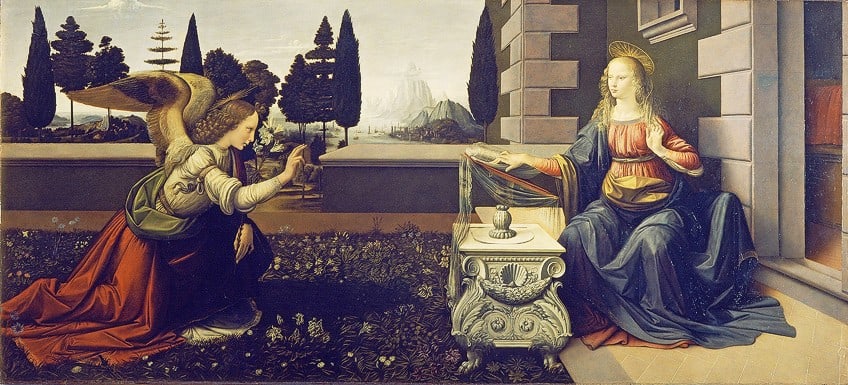
The Annunciation is also regarded as Da Vinci’s earliest known commissioned artwork that illustrates the artist’s innovative painting techniques such as sfumato as well as the use of atmospheric perspective. Gabriel is also one of the most famous angels in Renaissance paintings, seen in many illustrations of the Annunciation.
The Translation of the Holy House of Loreto (c. 1490) by Saturnino Gatti
| Artist Name | Saturnino Gatti (1463 – 1518) |
| Date | c. 1490 |
| Medium | Tempera and gold on wood |
| Dimensions (cm) | 84.5 x 54.9 |
| Where It Is Housed | The Metropolitan Museum of Art, New York City, United States |
Created by a pioneering artist of Abruzzo, Saturnino Gatti, this famous angel painting was inspired by the legend, which stated that in 1291, Mary’s home was transported by the angels after the Islamic defeat of the Crusaders. It was fabled that the house itself was uprooted and settled in Dalmatia and then in Loreto in 1294, which was established as the site of pilgrimage.
Gatti was a pre-Renaissance painter whose approach to portraying the angels in this scene makes the painting unique.

He portrays four angels whose gender appears ambiguous as per pre-medieval notions of angels in the bible who are seen lifting the virgin’s house and crowning her while the rosy-cheeked infant Jesus is seen on the roof of the house bearing a delighted expression. The scene is one of the happiest and most affectionate images of Mary and Jesus, which are also seen in the expressions of the angels.
The Sistine Madonna (1512 – 1513) by Raphael
| Artist Name | Raffaello Sanzio da Urbino (1483 – 1520) |
| Date | 1512 – 1513 |
| Medium | Oil on canvas |
| Dimensions (cm) | 201 x 269.5 |
| Where It Is Housed | Old Masters Picture Gallery, Dresden State Art Museums, Dresden, Germany |
The Sistine Madonna is perhaps one of the most famous angel paintings recognized by the two endearing cherubs at the bottom of the painting. The painting is also identified as Raphael’s most famous religious painting, commissioned by Pope Julius II in the 16th century. The painting was commissioned as a commemoration of the newfound unity of Piacenza with the Papal States and was intended for hanging at the San Sisto church in Piacenza.
The two cute cherubs in the painting were added by Raphael to finalize the composition and the second main attractions, aside from the Madonna and Christ.
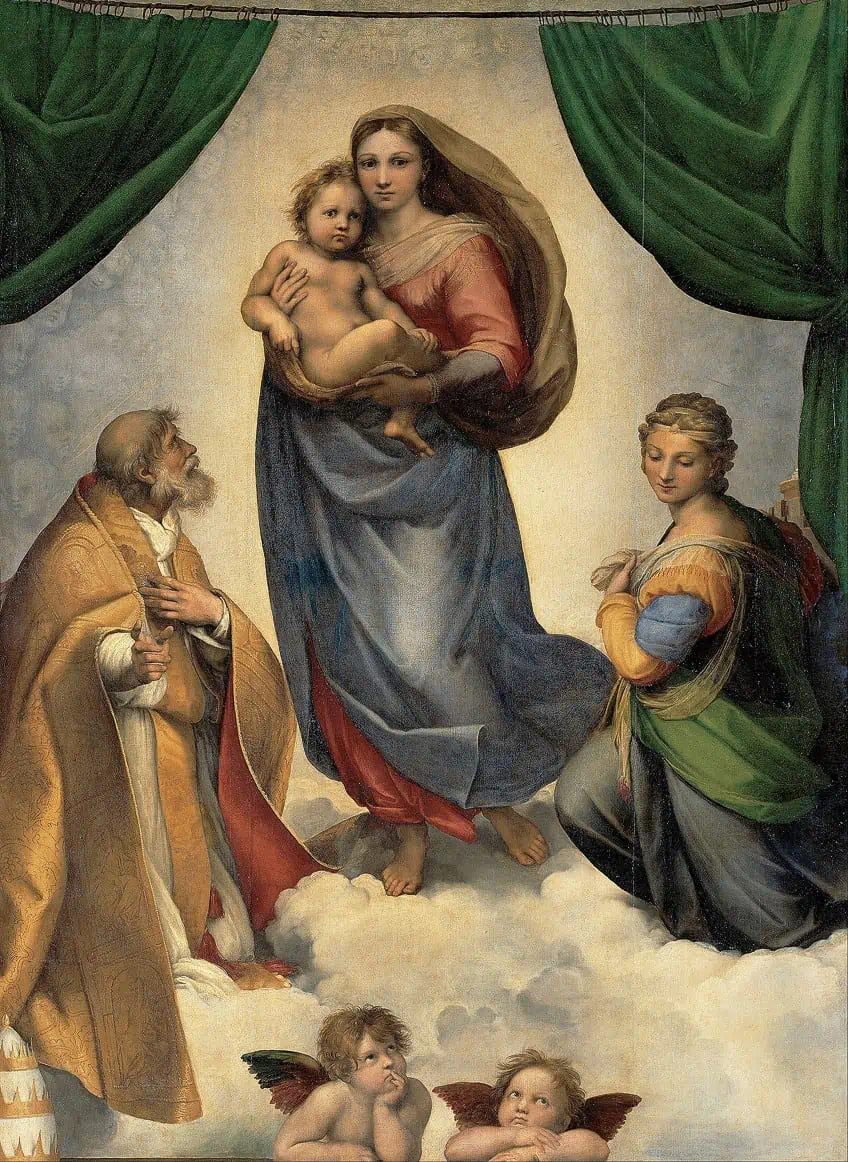
Saint Michael the Archangel (c. 1640s) by Ignacio de Ries
| Artist Name | Ignacio de Ries (1616 – 1665) |
| Date | c. the 1640s |
| Medium | Oil on canvas |
| Dimensions (cm) | 164.5 x 109.9 |
| Where It Is Housed | The Metropolitan Museum of Art, New York City, United States |
A combination of Flemish and Italian painting traditions is featured in the works of Spanish artist Ignacio de Ries who created this iconic scene of Michael the archangel casting Satan out of heaven and onto the Earth. This scene between two powerful angels cannot be missed in angel art history since archangel Michael is considered to be the chief of the angels.
Mention of the archangel appears as early as the 2nd century and is most famous in the Jewish book of Enoch and the book of Tobit, which introduce the angel without hesitation and suggest that he was regarded as highly important much earlier but without evidence of his mention before the Hellenistic period.
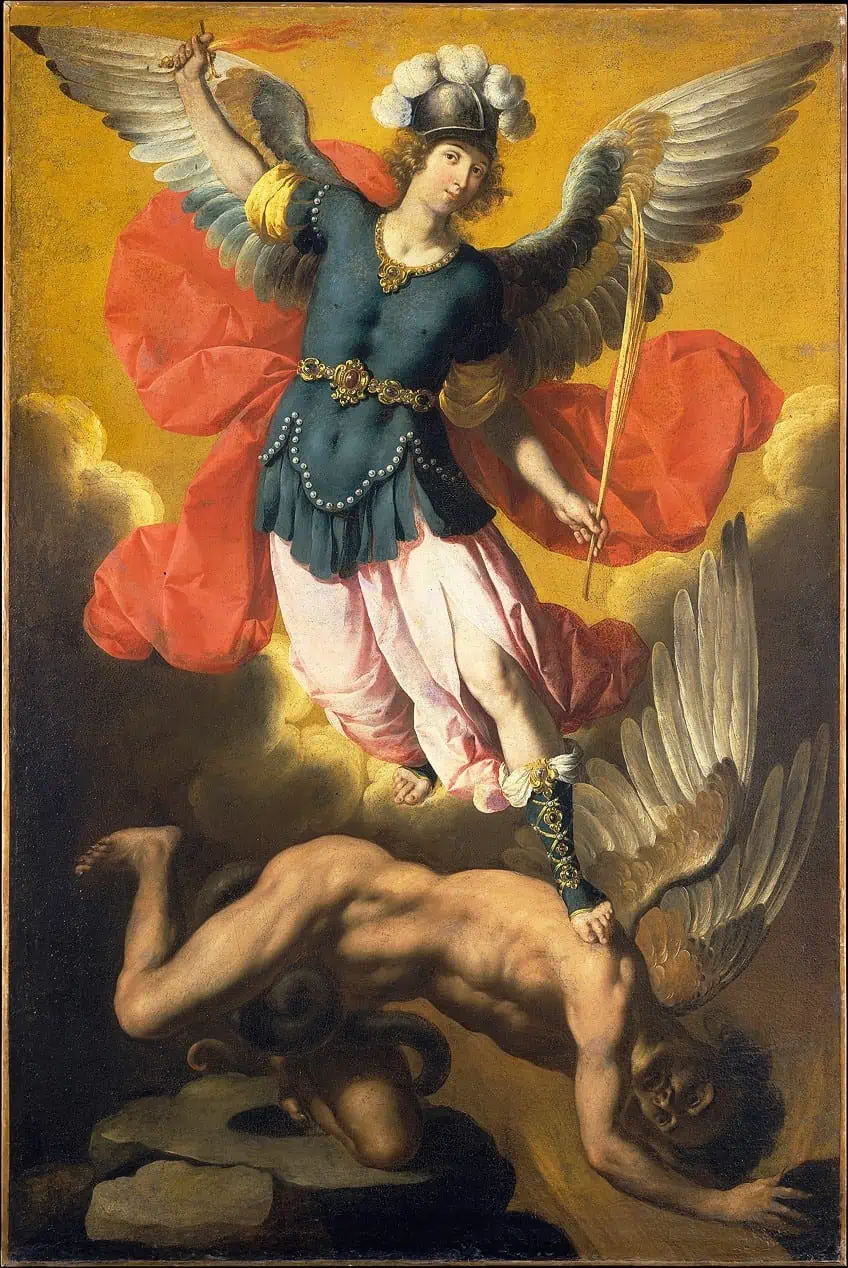
In other religious texts, Michael is also the protector of Israel and the defending champion of God in apocalyptic battles. In Islam, Michael takes the name of Mikal who interacts with the prophet Muhammed. According to Jewish tradition, Michael was often mentioned in battle with Samael, who was also an archangel according to Talmudic lore and represents Israel’s accuser.
The Dead Christ with Angels (1864) by Édouard Manet
| Artist Name | Édouard Manet (1832 – 1883) |
| Date | 1864 |
| Medium | Oil on canvas |
| Dimensions (cm) | 179.4 x 149.9 |
| Where It Is Housed | The Metropolitan Museum of Art, New York City, United States |
This famous Renaissance angel painting was created by art critics’ most controversial artist, Édouard Manet in 1864 depicting the corpse of Jesus Christ accompanied by two angels. Manet drew inspiration from the scene cited by Saint John, which specified that “Christ’s tomb was empty, except for two angels”. Manet sent off his painting to the Salon for review but soon realized his error in portraying Christ’s wound on the wrong side of his body and left himself to the art critics who went on to denounce the artwork due to the Realism of Jesus’ body.
The angels are also portrayed interestingly with one angel donning blue-feathered wings and the other who is seen with dark gray feathers.

Both angels appear ambiguous in gender with somber expressions as they hold Christ’s lifeless body. The image of the deceased Christ is also haunting due to the contrast and dramatic lighting on Christ’s face that leave his eyes lifeless in the shadows and gives one the impression that the light has momentarily left his face, meaning the viewer has also just witnessed the life of Christ leave his physical body.
Song of the Angels (1881) by William-Adolphe Bouguereau
| Artist Name | William-Adolphe Bouguereau (1825 – 1905) |
| Date | 1881 |
| Medium | Oil on canvas |
| Dimensions (cm) | 213.4 × 152.4 |
| Where It Is Housed | Forest Lawn Museum, California, United States |
The Virgin of the Angels also called the Song of the Angels is one of the most famous Renaissance angel paintings in art history, created by French classical painter William-Adolphe Bouguereau. The painting shows three angels serenading the young baby Jesus to sleep while Mary cradles him. Here, the angels are playing musical instruments and are all female angels dressed in white flowing robes.
The image of the angels reflects the traditional association of the angel with purity and cleanliness, as seen in their illuminated figures and the color white, which glows the brightest on Christ.
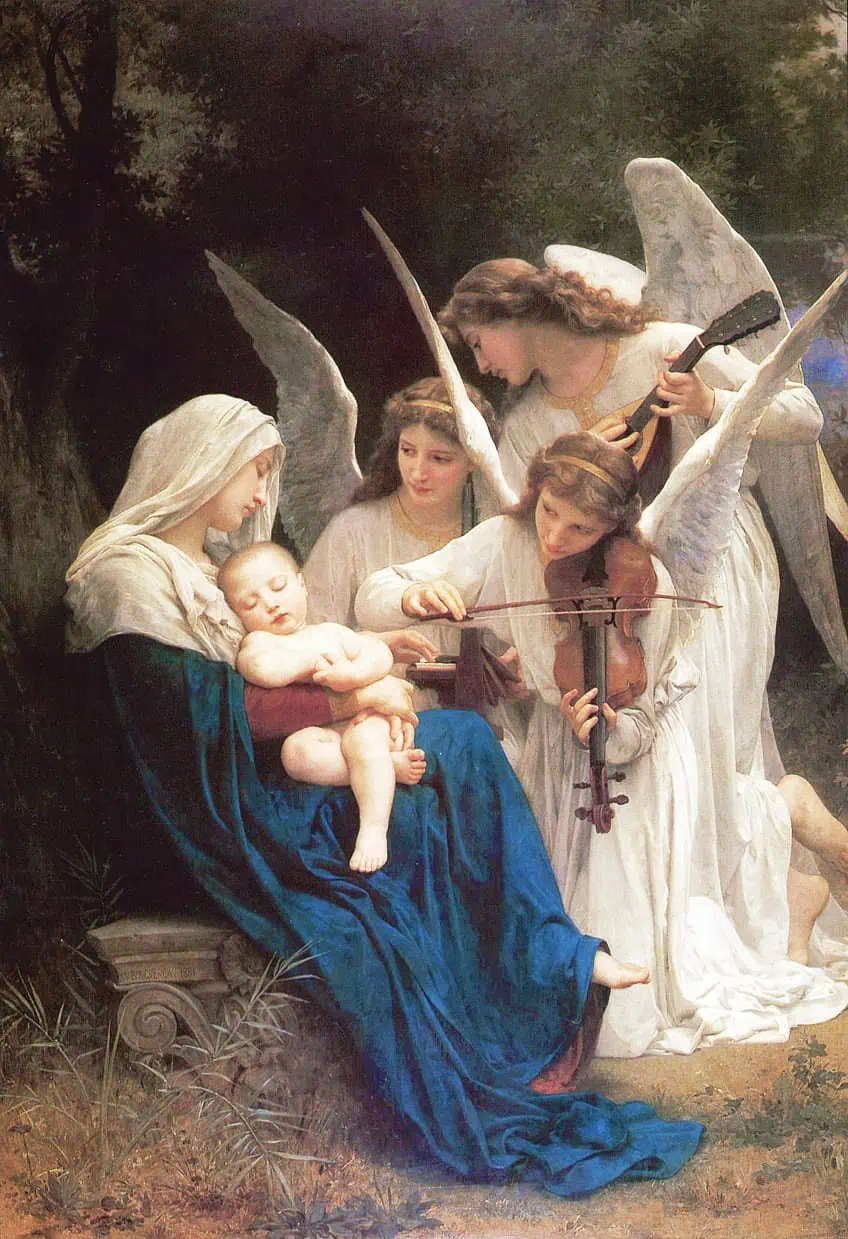
Flying Celestial (Apsara) with Musical Instrument (1942 – 1943) by Xie Zhiliu
| Artist Name | Xie Zhiliu (1910 – 1997) |
| Date | 1942 – 1943 |
| Medium | Ink on glassine |
| Dimensions (cm) | 25.5 x 38 |
| Where It Is Housed | The Metropolitan Museum of Art, New York City, United States |
Xie Zhiliu was one of the leading Modern Chinese painters who was a notable graduate of the Shanghai School of Art. Xie Zhiliu created this angel painting in the mid-20th century and had been painting since the young age of nine. Inspired by the art styles of Chen Hongshou and influenced by his contemporary Zhang Daqian, Xie Zhiliu illustrates a flying celestial creature, perceived to be an angel of unknown rank, who bears a stringed instrument. It is unclear whether the figure was meant to have wings but the figure seems to be whisked by the wind or perhaps exercising its invisible flying powers. The angel’s expression is also gleeful while the painting style remains linear and direct in a playful manner. The figure is believed to represent an “apsara”, which is a class of celestial beings belonging to the Buddhist and Hindu cultures. They are originally portrayed as femme spirits who act as nymphs and rule the clouds and water.
Angel art history is incredibly fascinating to study since the different depictions of angels and their characters are not only shared between different belief systems, but are also powerful symbols of hope and faith. We hope that you have enjoyed these angel artworks, and have gained a new appreciation for the intricate thought and eye for detail that artists have put into these artworks over the centuries.
Frequently Asked Questions
What Do Angels in Art Symbolize?
Angels in art are symbols of the divine and have been associated with complex religious themes in art history. These include angels representing celestial beings or messengers of God who possess supernatural powers to guide humanity to salvation. Angels are associated with benevolence, protection, and a connection to the cosmos. There are many different types of angels and in paintings, they often serve as personal guides who accompany humans on their personal journeys.
Why Are Angels Depicted With Wings in Art?
Angels did not initially possess wings in artistic representations. The wings were added to distinguish the celestial beings from the human form and present them as bird-like creatures of grace and elegance, who carry messages from God. Wings are thus the connecting element between the human world and the heavenly world and signify that all angels, like birds, do return to Earth. The 4th century saw the emergence of wings in angel artworks.
What Is the First Angel Painting in Art History?
The first known angel painting in art history is considered to be a fresco portraying the Annunciation in the Catacomb of Priscilla. The fresco is situated at the Cubicolo dell’Annunciazione and was created by an unknown artist. The painting does not portray a figure with wings; however, it is believed to illustrate the Annunciation scene, in which the angel Gabriel and Jesus’ soon-to-be mother Mary interact. It remains a subject of debate whether the Priscilla catacomb painting represents the Annunciation or not.
Jordan Anthony is a Cape Town-based film photographer, curator, and arts writer. She holds a Bachelor of Art in Fine Arts from the University of the Witwatersrand, Johannesburg, where she explored themes like healing, identity, dreams, and intuitive creation in her Contemporary art practice. Jordan has collaborated with various local art institutions, including the KZNSA Gallery in Durban, the Turbine Art Fair, and the Wits Art Museum. Her photography focuses on abstract color manipulations, portraiture, candid shots, and urban landscapes. She’s intrigued by philosophy, memory, and esotericism, drawing inspiration from Surrealism, Fluxus, and ancient civilizations, as well as childhood influences and found objects. Jordan is working for artfilemagazine since 2022 and writes blog posts about art history and photography.
Learn more about Jordan Anthony and about us.
Cite this Article
Jordan, Anthony, “Angel Art History – Famous Angels in Renaissance Paintings.” artfilemagazine – Your Online Art Source. May 9, 2023. URL: https://artfilemagazine.com/angel-art-history/
Anthony, J. (2023, 9 May). Angel Art History – Famous Angels in Renaissance Paintings. artfilemagazine – Your Online Art Source. https://artfilemagazine.com/angel-art-history/
Anthony, Jordan. “Angel Art History – Famous Angels in Renaissance Paintings.” artfilemagazine – Your Online Art Source, May 9, 2023. https://artfilemagazine.com/angel-art-history/.


